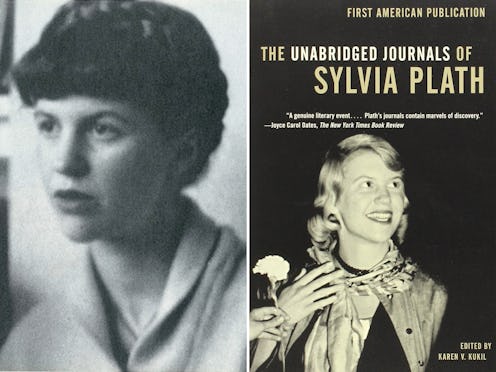Books

Poet and author Sylvia Plath's writing was emotional and electric, but unfortunately, many people still only know her by her death. Indeed, a lot of Plath's life was painful. But throughout it all, she continued to write.
When I love an author, I'm insatiable for information about them. In the case of Plath, it's especially important that readers consider the larger picture of the author's life, especially since so much of her personal experiences bore direct influence on her writing and her life extended so far beyond her mental illness and death.
Much of what we know of Plath's life comes from her letters and journals, which have now been published in various collections. But it should also be noted that after her death, Plath's estate was controlled by Ted Hughes, as their divorce had not yet gone through at the time of her death. Hughes admits in his foreword to The Journals of Sylvia Plath that he destroyed her final journal, and many Plath scholars are wary of his influence over her publications.
There's a lot we can learn about Plath's life that can help us better understand her writing. So, here are 10 facts about Sylvia Plath that may change what you think about the author:
1
She published her first poem when she was eight years old.
It was called "Poem" and it was published in the Boston Herald in 1941. It's short and sweet, and quite different from the darker poetry Plath wrote later in life:
"Hear the crickets chirping
In the dewy grass.
Bright little fireflies
Twinkle as they pass."
2
She was also a visual artist.
In fact, she originally majored in studio art at Smith College before switching to English. From collages to paintings, much of her art uses the abstract in unique ways. Her visual art was recently put on display at the Smithsonian National Gallery and you see it in person until May 20, 2018.
3
At age 12, her IQ was recorded at around 160.
For reference, the range for being considered a genius begins at 140. Even without knowing her IQ, it's clear from her work that Plath was extremely intelligent. She was a gifted student throughout her life, winning numerous scholarships and awards — including a scholarship to Smith College.
4
Her father died when she was eight, and this experience inspired much of her work.
Otto Plath died unexpectedly due to complications after the amputation of his foot from untreated diabetes. His death had a significant impact on Plath, and was the inspiration for many of her poems, including one of her most famous: "Daddy."
5
She won a Fulbright Scholarship.
With this prestigious scholarship, Plath went on to study at Newham College in Cambridge, England. She studied under Dorothea Krook, an Israeli literary scholar that Plath held in high regard. Plath kept writing throughout her time in Cambridge, and traveled through Europe over the summer.
6
She chose June 16th for her wedding date in honor of James Joyce's Novel 'Ulysses'
It was at a party in Cambridge that Plath met her eventual husband, poet Ted Hughes. On June 16th, 1956, Plath married Hughes, paying homage to the day on which James Joyce's Ulysses takes place. Unfortunately, the writers' marriage was tumultuous and painful, and recently discovered letters reveal that Hughes abused Plath.
7
'The Bell Jar' was originally rejected by publishers.
Plath received a $2,080 novel-writing fellowship from the publisher Harper & Row, but when she turned in her manuscript they declined to publish it. An editor at Harper & Row called it "disappointing, juvenile and overwrought." The novel was eventually published in the U.K., but Plath was not able to find a U.S. publisher for it in her lifetime.
8
She originally published 'The Bell Jar' under the pen name "Victoria Lucas."
The semi-autobiographical novel was re-published under her own name in the U.K. in 1966, three years after her suicide. However, there was controversy over whether Plath would have wanted the book published under her own name. According to a close friend of Plath's, she published the book under a pseudonym because she didn't want to upset her mother or anyone who was mentioned in the book. In response, publisher Faber and Faber claimed that there was no evidence that Plath would not have wanted her name on the book posthumously. Meanwhile, Plath's mother prevented the book from being published in the US until 1971, because she didn't want people she knew to recognize themselves in the book.
9
Plath received electroshock therapy for her clinical depression.
While not everything in The Bell Jar corresponds to Plath's life, she drew on many of her own experiences to write the novel. Just like Esther in The Bell Jar, Plath received electroshock therapy as treatment for her depression and was hospitalized several times over the course of her life. She received her first electroshock treatment after her first suicide attempt at the age of 20. She was treated at Maclean Hospital in Massachusetts, which has also treated Robert Lowell, Anne Sexton, David Foster Wallace, James Taylor, and Ray Charles.
10
She lived in an apartment that had been previously occupied by W.B. Yeats.
Literary heritage seems to be a major theme in Plath's life. The last apartment Plath lived in had been previously owned by the renowned poet W.B. Yeats. (It was here where she died by suicide in 1963.) You can find the apartment at 3 Fitzroy Road in London.